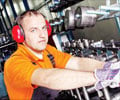A new law limiting noise exposure at the workplace is plunging European orchestras into serious difficulties. The law took effect for the entertainment industry this month.
Musicians are being asked to wear decibel-measuring devices and to sit behind see-through anti-noise screens. Companies are altering their repertories. And conductors are reconsidering the definition of “fortissimo.” (The term means a direction to play loudly.)Alan Garner, an oboist and English horn player who is the chairman of the players’ committee at the Royal Opera House, said that he and his colleagues had been told that they would have to wear earplugs during entire three-hour rehearsals and performances.
“It’s like saying to a racing-car driver that they have to wear a blindfold,” he said.
Already there are signs that the law is altering not only the relationship between classical musicians and their employers, but also between musicians and the works they produce, writes Sarah Lyall in New York Times.
“The noise regulations were written for factory workers or construction workers, where the noise comes from an external source, and to limit the exposure is relatively straightforward,” said Mark Pemberton, the director of the Association of British Orchestras. “But the problem is that musicians create the noise themselves.”
Rock musicians have talked openly about loud music and ear protection for years. The issue is more delicate for classical musicians, who have been reluctant to accept that their profession can lead to hearing loss, even though studies have shown that to be the case. At the same time, complying with the law — which concerns musicians’, not audiences’, noise exposure — is complicated.
Advertisement
Orchestras are also installing noise-absorbing panels and placing anti-noise screens at strategic places, like in front of the brass section, to force the noise over the heads of other players.
Advertisement
They are also trying to put more space between musicians, and rotating them in and out of the noisiest seats.
At the Royal Opera House, the management has devised a computer program that calculates individual weekly noise exposure by cross-referencing such factors as the member’s schedule and the pieces being played.
Musicians are spacing out rehearsals and playing more softly when they can. As the Welsh National Opera prepared for the premiere of James MacMillan’s loud opera, “The Sacrifice,” last year, the brass and percussion sections were told to take it easy at times in rehearsal to protect the ears of themselves and their colleagues, said Peter Harrap, the orchestra and chorus director.
Conductors are also being asked to reconsider their habit of “going for a big loud orchestration,” said Chris Clark, the orchestra operations manager at the Royal Opera House. Composers, too, are being asked to keep the noise issue in mind.
And companies are examining their repertories with the aim of interspersing loud pieces — Mahler’s symphonies, for instance — with quieter ones. They are also buying a lot of high-tech earplugs, which are molded to players’ ears and cost about $300 a pair. Many orchestras now ask their musicians to put the earplugs in during the loud parts of a performance.
“I have a computer program that gives me a minute-by-minute timeline chart through the whole piece,” said Turbett of the English National Opera. “I can go back to the musicians and say, ‘Between bar 100 and bar 200, there’s a very loud passage, so please put in hearing protection.’ ”
But these remedies can bring problems. Some musicians in the brass and percussion sections resent being screened off from their colleagues, as if they were being ostracized. Musicians, even if they accept the need to use earplugs occasionally, tend to hate wearing them.
Garner, the Royal Opera House oboist, said: “I’ve spent nearly 30 years in music and I know all about noise, and occasionally, if I’m not playing and there’s a loud bit next to me, I might shove my fingers in my ears for a few bars. But I have yet to find a musician who says they can wear earplugs and still play at the same level of quality.”
Source-Medindia
GPL/L







